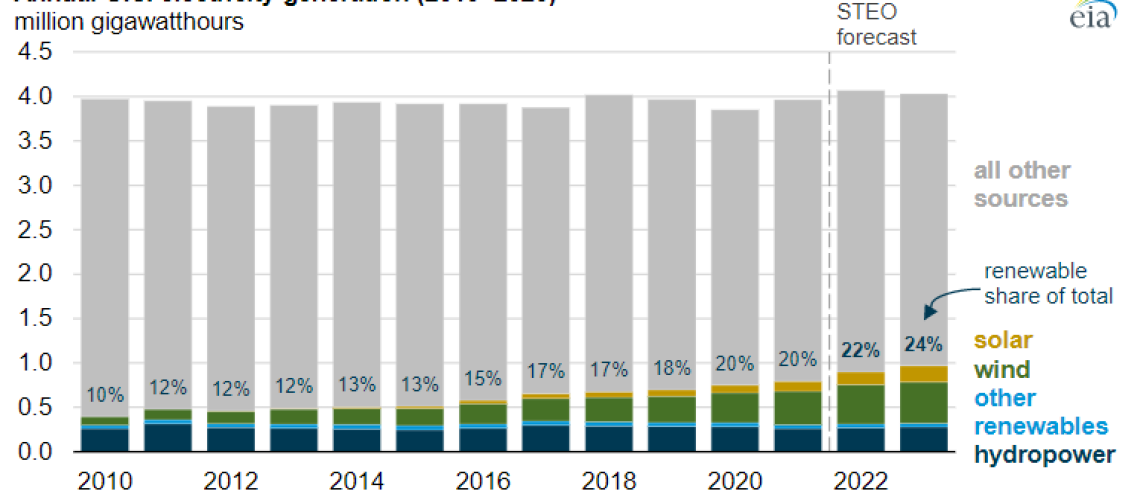The Energy Information Administration projects renewable energy to reach a record share of generation mix this year.
Renewable energy will climb another rung of the ladder in the energy transition in 2022, reaching 22% of all generation this year, said the Energy Information Administration (EIA). EIA categorizes renewable energy as solar, wind, and hydropower, as well as other renewables like biomass and geothermal.
The category reached 20% in both 2020 and 2021. EIA said it expects renewable energy to account for 24% of all generation next year. The organization regularly posts forecasts for five renewable energy sources: conventional hydropower, wind, solar, biomass, and geothermal based on its monthly historical data releases.
EIA tracks 11 distinct regions in its renewable energy generation report. In 2021, the top two regions for renewable energy were California, where renewables accounted for 44% of electricity generation and the Northwest, where renewables accounted for roughly 50% of the region’s electricity generation. EIA said droughts hampered the hydroelectric contribution to these numbers, but they still increased their renewable share in the generation mix through buildout of solar and wind.
The most significant growth in renewables generation share this past decade was in the Southwest Power Pool, where renewable energy has grown from 13% of the mix in 2013 to 44% in 2022. This was largely due to wind generation additions, said EIA. The Electric Reliability Council of Texas also increased its renewables share from 10% to 32% over the same time period.
Three East Coast regions had the lowest share of renewable energy generation in their mix, namely PJM Interconnection in the Mid-Atlantic, the Southeast, and the Florida Reliability Coordinating council. EIA expects these regions to remain below the national average for renewables through next year. Natural gas and nuclear are the most significant power generators in the Southeast and Florida regions, and in PJM, the most prevalent power providers are natural gas and coal.
A distinction should be made between “renewable” and “sustainable” energy. Johns Hopkins University describes renewable energy as something that comes from sources that naturally renew themselves to meet our energy needs. This can include such technologies as biomass, hydropower, etc. “Sustainable” energy is defined as energy that can support both the current generation as well as future generations. John Hopkins considers solar and wind as the primary sources of sustainable energy.
Following the passage of the Inflation Reduction Act, sustainable energy sources are set to be significantly boosted by long-term industrial policy. In a collaboration with research institutions called the REPEAT project, Princeton University said solar deployment may accelerate from 2020 rates of 10 GW of capacity added per year to nearly five times as much by 2024, adding 49 GW of utility-scale solar each year. Solar deployment may be well over 100 GW per year by 2030, said the analysts. This will lead to the presence of renewable energy in the total U.S. generation mix being much more robust a decade from now.



